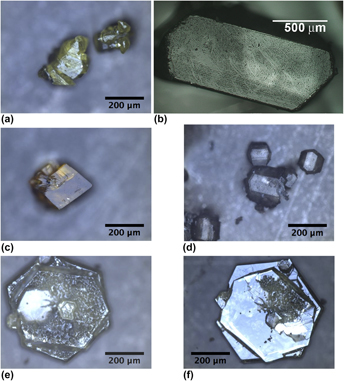Crossref Citations
This article has been cited by the following publications. This list is generated based on data provided by
Crossref.
Mannepalli, Sowjanya
and
Mangalampalli, Kiran
2017.
Indentation Plasticity and Fracture Studies of Organic Crystals.
Crystals,
Vol. 7,
Issue. 11,
p.
324.
Burch, Alexandra
Yeager, John
and
Bahr, David
2017.
Nanoindentation of HMX and Idoxuridine to Determine Mechanical Similarity.
Crystals,
Vol. 7,
Issue. 11,
p.
335.
Olson, Isabel A
Shtukenberg, Alexander G
Kahr, Bart
and
Ward, Michael D
2018.
Dislocations in molecular crystals.
Reports on Progress in Physics,
Vol. 81,
Issue. 9,
p.
096501.
Liu, Fan
Hooks, Daniel E.
Li, Nan
Mara, Nathan A.
and
Swift, Jennifer A.
2018.
Mechanical Properties of Anhydrous and Hydrated Uric Acid Crystals.
Chemistry of Materials,
Vol. 30,
Issue. 11,
p.
3798.
Lafourcade, Paul
Denoual, Christophe
and
Maillet, Jean-Bernard
2018.
Irreversible Deformation Mechanisms for 1,3,5-Triamino-2,4,6-Trinitrobenzene Single Crystal through Molecular Dynamics Simulations.
The Journal of Physical Chemistry C,
Vol. 122,
Issue. 26,
p.
14954.
Fan, Junyu
Su, Yan
Zhang, Qingyu
and
Zhao, Jijun
2019.
Determination of second- and third-order elastic constants for energetic materials.
Computational Materials Science,
Vol. 161,
Issue. ,
p.
379.
Manimunda, Praveena
Syed Asif, S. A.
and
Mishra, Manish Kumar
2019.
Probing stress induced phase transformation in aspirin polymorphs using Raman spectroscopy enabled nanoindentation.
Chemical Communications,
Vol. 55,
Issue. 62,
p.
9200.
Lafourcade, Paul
Denoual, Christophe
and
Maillet, Jean-Bernard
2019.
Mesoscopic constitutive law with nonlinear elasticity and phase transformation for the twinning-buckling of TATB under dynamic loading.
Physical Review Materials,
Vol. 3,
Issue. 5,
Pal, Anirban
and
Picu, Catalin R.
2019.
Non-Schmid effect of pressure on plastic deformation in molecular crystal HMX.
Journal of Applied Physics,
Vol. 125,
Issue. 21,
Burch, Alexandra C.
Yeager, John D.
and
Bahr, David F.
2019.
Indentation fracture behavior of energetic and inert molecular crystals.
Journal of Materials Research,
Vol. 34,
Issue. 23,
p.
3954.
Grilli, Nicolò
and
Koslowski, Marisol
2019.
The effect of crystal anisotropy and plastic response on the dynamic fracture of energetic materials.
Journal of Applied Physics,
Vol. 126,
Issue. 15,
Naumov, Panče
Karothu, Durga Prasad
Ahmed, Ejaz
Catalano, Luca
Commins, Patrick
Mahmoud Halabi, Jad
Al-Handawi, Marieh B.
and
Li, Liang
2020.
The Rise of the Dynamic Crystals.
Journal of the American Chemical Society,
Vol. 142,
Issue. 31,
p.
13256.
Burch, Alexandra C.
Wilde, Zakary R.
Bahr, David F.
and
Yeager, John D.
2020.
A Thermal and Nanomechanical Study of Molecular Crystals as Versatile Mocks for Pentaerythritol Tetranitrate.
Crystals,
Vol. 10,
Issue. 2,
p.
126.
Wang, Chenguang
and
Sun, Changquan Calvin
2020.
The landscape of mechanical properties of molecular crystals.
CrystEngComm,
Vol. 22,
Issue. 7,
p.
1149.
Pinal, Rodolfo
and
Carvajal, M. Teresa
2020.
Integrating Particle Microstructure, Surface and Mechanical Characterization with Bulk Powder Processing.
KONA Powder and Particle Journal,
Vol. 37,
Issue. 0,
p.
195.
Liu, Fan
Hooks, Daniel E.
Li, Nan
Rubinson, Judith Faye
Wacker, Jennifer N.
and
Swift, Jennifer A.
2020.
Molecular Crystal Mechanical Properties Altered via Dopant Inclusion.
Chemistry of Materials,
Vol. 32,
Issue. 9,
p.
3952.
Gabriele, Benjamin P. A.
Williams, Craig J.
Lauer, Matthias Eckhard
Derby, Brian
and
Cruz-Cabeza, Aurora J.
2020.
Nanoindentation of Molecular Crystals: Lessons Learned from Aspirin.
Crystal Growth & Design,
Vol. 20,
Issue. 9,
p.
5956.
Ghosh, Soumyajit
and
Mishra, Manish Kumar
2021.
Elastic Molecular Crystals: From Serendipity to Design to Applications.
Crystal Growth & Design,
Vol. 21,
Issue. 4,
p.
2566.
Suzuki, Ryo
Shigemoto, Chika
Abe, Marina
Kojima, Kenichi
and
Tachibana, Masaru
2021.
Analysis of slip systems in protein crystals with a triclinic form using a phenomenological macro-bond method.
CrystEngComm,
Vol. 23,
Issue. 20,
p.
3753.
Barr, Christopher M.
Cooper, Marcia
Lechman, Jeremy
and
Bufford, Daniel C.
2021.
The mechanical response of micron-sized molecular crystals.
MRS Advances,
Vol. 6,
Issue. 27,
p.
674.
